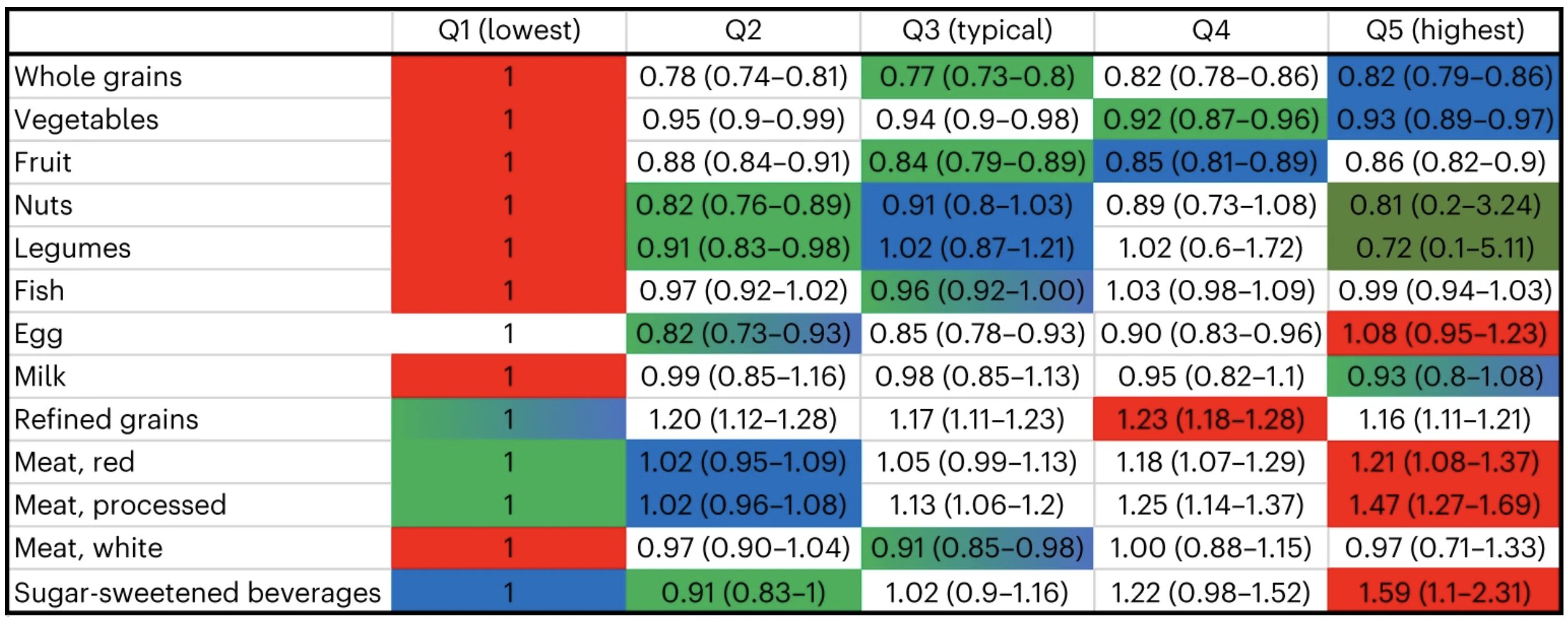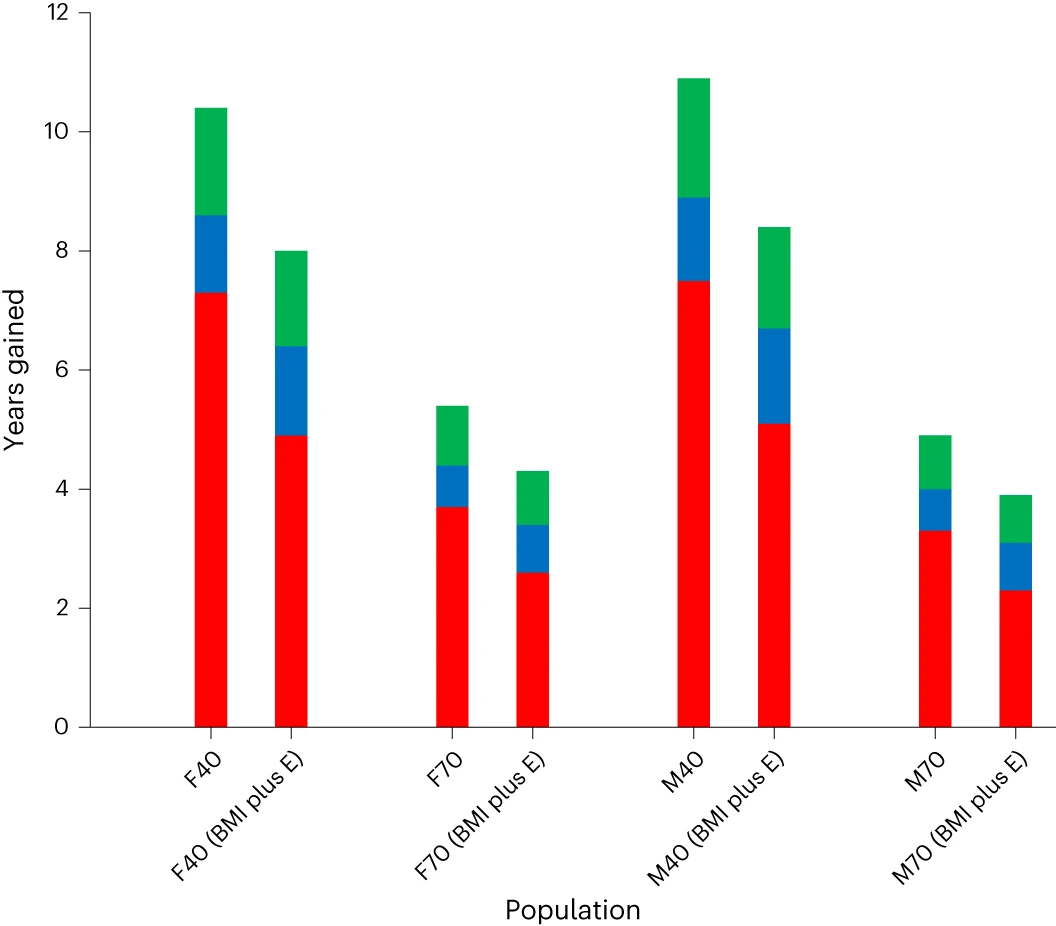How much longer will I live by switching to a healthy diet?

Look, we all know we are supposed to ‘eat healthier’ to feel better.
I think if most of us really think about it we also know that as a broad generality those that eat healthy tend to live longer.
But has that ever actually been studied? Exactly how much longer can we expect to live if we switch to a healthy diet?
Somebody in clinic asked me this question recently so I went down a bit of a rabbit hole and found a great study from last year in the prestigious Nature Food journal that looked to answer exactly this question.
This was another UK Biobank study. As a refresher as we have talked about many biobank studies in the past, the UK Biobank is often called the world’s most important health research database.
It has data on over half a million participants since recruitment began in 2006. They collect all kinds of information on these people across all forms of health and have been following them along ever since to help us collect real world datapoints to improve human health.
This particular study looked at 467,354 participants, and specifically looked at diet, and modeled out how changes in diet would impact how long they live.
Why is this important?
In the UK alone, unhealthy diets are estimated to cause over 75,000 premature deaths yearly and this is likely increasing.
In the UK there has also been a big push to follow an NHS funded program called the Eatwell Guide. Essentially this constitutes their version of the food pyramid.
It has been claimed that higher adherence to the recommendations of the Eatwell Guide is associated with reduced mortality but it is not known how much longer someone may be expected to live if they start to follow the Eatwell guide at different points in their lives.
The researchers in this paper created a model to estimate age and sex specific gains or losses in life expectancy by following a sustained change in diet based on the consumption of major food groups.
How did they do this? Here is a short explanation in simplified terms (and the results):
They began by categorizing the average dietary patterns in the UK as the ‘intake level’ based on the biobank study (the study included nutrition as part of the intake and was quite detailed).
Then they split each of the major food groups into quintiles (essentially just evenly split into 5 categories from low intake to high intake for grains as an example). The average diet from the biobank data was deemed to be right in the middle.
They had 2 starting points for the study: The midpoint as discussed above, and then one called the ‘unhealthy diet’, that consisted of the red highlighted portion of each food group in the chart below.

For the comparison diets they used the Eatwell Guide which is the blue highlighted portions, or a longevity diet which is the green and dark green highlighted portions.
A quick aside….I was curious how they defined the ‘longevity diet’. It was created based upon the quintiles for each food group with the lowest mortality risk estimates. So if eating a low amount of red or processed meat is associated with low mortality risk it was rated in the lowest quintile. If nuts or legumes are associated with living longer (they are), then it was rated primarily in the highest quintile. The unhealthy group was the exact opposite. It was the quintiles for each group with the highest mortality association.
They fed all of this information into their model and found the following:
- The strongest association with mortality was sugar sweetened beverages and processed meat (no surprise there).
- The strongest association for increased life expectancy was whole grains and nuts.
- Here is the chart displaying the expected differences in lifespan estimates.

-
- The remaining life expectancy of a 40 year old with median dietary patterns was 44.7 years for females and 41.6 years for males.
- For 70 year old females it was 17.6 years and for males 15.5 years.
- Here is where things get interesting:
- The estimated gain from dietary changes from the median diet to the longevity diet is 3.1 years for 40 year old females and 3.4 years for 40 year old males (so you will live 3.1 extra years for a 40 year old female for example by following the longevity diet).
- For sustained changes to the Eatwell diet it was 1.3 years for 40 year old females and 1.4 years for males.
- Now the really interesting findings:
- If you start in the UNHEALTHY UK diet pattern and change to a sustained longevity pattern, the model suggests you will add 10.4 extra years to your life for a 40 year old female and 10.8 years for a 40 year old male.
- Even more striking is if you reach 70 and are on the UNHEALTHY diet, you will add an extra 5.4 years for females and 5 for males by switching to the longevity diet.
- For the Eatwell diet from the unhealthy diet it was 8.6 extra years for 40 year old females and 8.9 years for 40 year old males.
- For 70 year old females switching to the Eatwell diet they added an estimated 4.4 extra years and 4 for males.
When I was researching this article I found all kinds of news clips saying ‘switching to a longevity diet will earn you an extra 10 years’.
I am always suspicious of headlines like this and this time was no exception.
There is one GLARING ISSUE with this study.
It is a model! Convincing someone who has been eating literally the bottom 20% of every single food group to switch to the healthiest group is not just unlikely, it’s next to impossible. (Trust me, we try!)
In fact, buried in the study was this beauty of a sentence:
“Research has shown that less than 0.1% of the UK population adheres to all recommendations of the Eatwell Guide.”
Zero point one percent! That’s literally one out of every one thousand people that are actually following the UK version of the food guide. Yet we expect that people eating poorly will just magically switch to eating in the top 20% of each food group just by reading a headline that it will make them live longer?
I like baby steps.
Instead of focussing on the 10 years added by switching from the lowest quintile to the highest quintile (which in my opinion is highly unlikely to occur) lets instead focus on one simple finding from the study.
They found that the two most important food groups to avoid to increase your life expectancy are sweetened beverages and processed meats.
The two most important food groups to consume more of to increase your life expectancy are whole grains and nuts.
Let’s end with the most no brainer conclusion I have ever read in a study:
“Overall the bigger the changes made towards healthier dietary patterns, the larger the expected gains in life expectancy are”.
No kidding.
